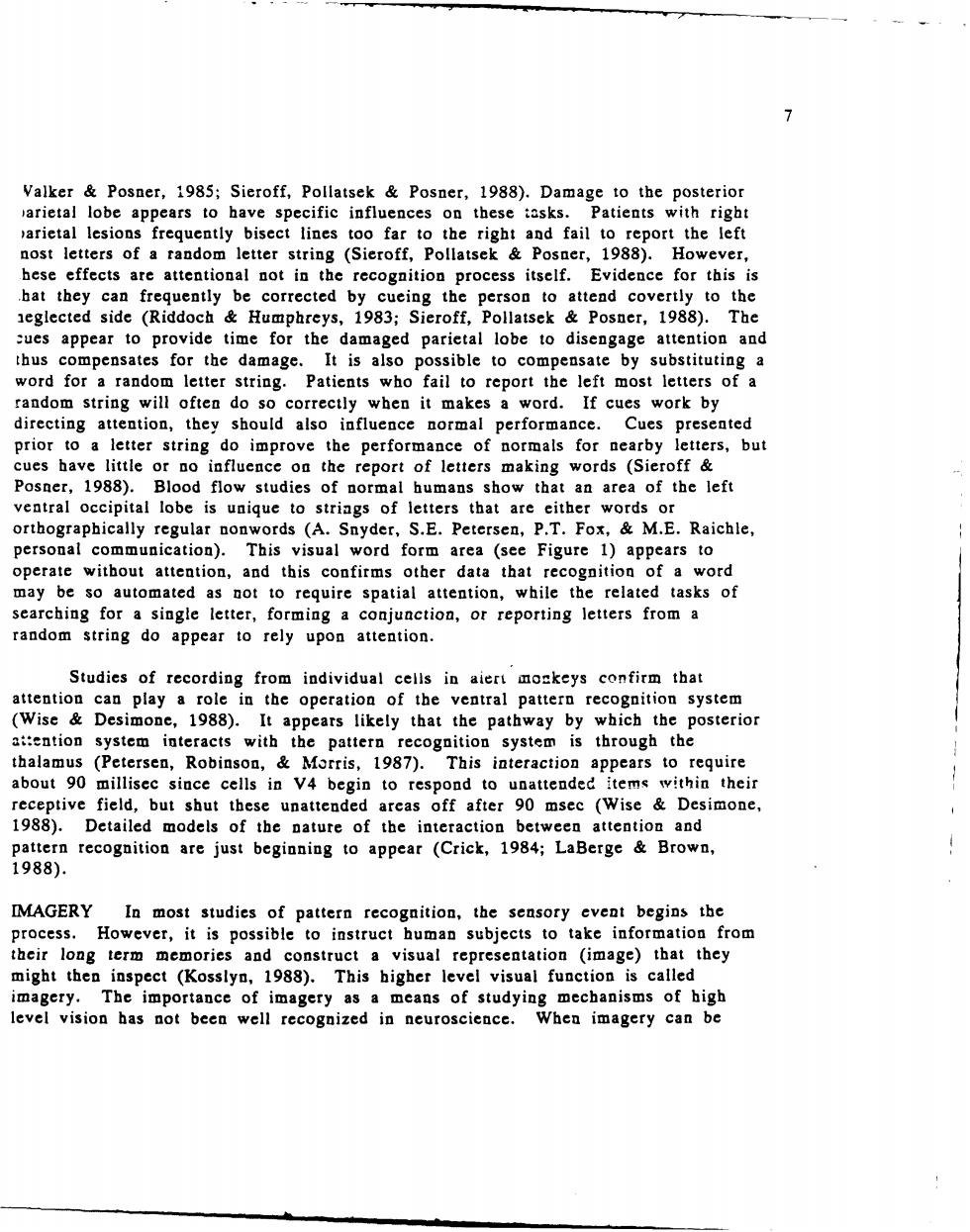正在加载图片...

Valker Posner,1985;Sieroff,Pollatsek Posner,1988).Damage to the posterior arietal lobe appears to have specific influences on these tasks. Patients with rigbt parietal lesions frequently bisect lines far to the right and fail to report the left nost letters of a tandom letter string (Sieroff,Pollatsek Posner,1988).However. hese effects are attentional not in the recognition process itself.Evidence for this is hat they can frequently be corrected by cueing the person to attend covertly to the neglected side (Riddoch Humphreys,1983:Sieroff,Pollatsek Posner,1988).The cues appear to provide time for the damaged parietal lobe to disengage attention and thus e pensates for the damage It is also ssible to substituting word for a random letter Patients ho fail to report the left most letters of a tring will do it o ord by should etter d mpro per TS, but uen 1988). report letters of n area left le y & ME Raichle, a Figure with oper 6 ut this contirm tha not to require spatial att sks of rching single letter,forming a conjunct or reporting letters from a random string do appear to rely upon attention. Studies of recording from individual cells in aiert mokeys confirm that attent can play a role in the operation of the ventral pattern recognition system (Wise Desimone,1988).It appears likely that the pathway by which the posterior aiention system interacts with the pattern recognition system is through the thalamus (Petersen,Robinson,Morris,1987).This interaction appears to require about 90 millisec since cells in v4 begin to respond to unattended items within their receptive field,but shut these unattended areas off after 90 msec (Wise Desimone. 1988).Detailed models of the nature of the interaction between attention and pattern recognition are just beginning to appear (Crick,1984;LaBerge Brown, 1988). [MAGERY In most studies of pattern recognition,the sensory event begins the process.However,it is possible to instruct human subjects to take information from their long term memories and construct a visual representation (image)that they might then inspect (Kosslyn,1988).This bigher level visual function is called imagery.The importance of imagery as a means of studying mechanisms of high level vision has not been well recognized in neuroscience. When imagery can be 7 Valker & Posner, 1985; Sieroff, Pollatsek & Posner, 1988). Damage to the posterior )arietal lobe appears to have specific influences on these tasks. Patients with right )arietal lesions frequently bisect lines too far to the right and fail to report the left nost letters of a random letter string (Sieroff, Pollatsek & Posner, 1988). However, hese effects are attentional not in the recognition process itself. Evidence for this is hat they can frequently be corrected by cueing the person to attend covertly to the ,eglected side (Riddoch & Humphreys, 1983; Sieroff, Pollatsek & Posner, 1988). The :ues appear to provide time for the damaged parietal lobe to disengage attention and thus compensates for the damage. It is also possible to compensate by substituting a word for a random letter string. Patients who fail to report the left most letters of a random string will often do so correctly when it makes a word. If cues work by directing attention, they should also influence normal performance. Cues presented prior to a letter string do improve the performance of normals for nearby letters, but cues have little or no influence on the report of letters making words (Sieroff & Posner, 1988). Blood flow studies of normal humans show that an area of the left ventral occipital lobe is unique to strings of letters that are either words or orthographically regular nonwords (A. Snyder, S.E. Petersen, P.T. Fox, & M.E. Raichle, personal communication). This visual word form area (see Figure 1) appears to operate without attention, and this confirms other data that recognition of a word may be so automated as not to require spatial attention, while the related tasks of searching for a single letter, forming a conjunction, or reporting letters from a random string do appear to rely upon attention. Studies of recording from individual cells in aiert monkeys confirm that attention can play a role in the operation of the ventral pattern recognition system (Wise & Desimone, 1988). It appears likely that the pathway by which the posterior a.:ention system interacts with the pattern recognition systew is through the thalamus (Petersen, Robinson, & Morris, 1987). This interaction appears to require about 90 millisec since cells in V4 begin to respond to unattended ltermq within their receptive field, but shut these unattended areas off after 90 msec (Wise & Desimone, 1988). Detailed models of the nature of the interaction between attention and pattern recognition are just beginning to appear (Crick, 1984; LaBerge & Brown, 1988). IMAGERY In most studies of pattern recognition, the sensory event begins the process. However, it is possible to instruct human subjects to take information from their long term memories and construct a visual representation (image) that they might then inspect (Kosslyn, 1988). This higher level visual function is called imagery. The importance of imagery as a means of studying mechanisms of high level vision has not been well recognized in neuroscience. When imagery can be